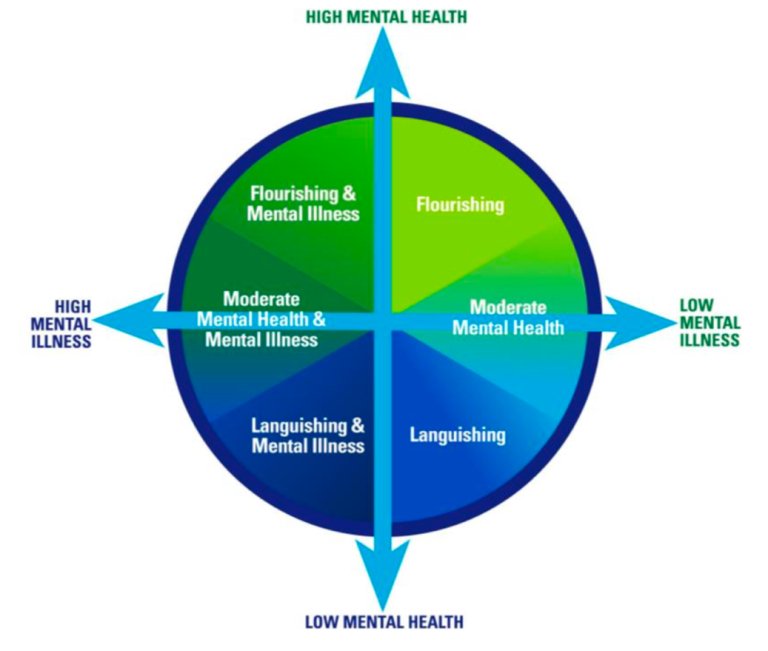It is possible to have a mental illness and be mentally healthy? This article explores this question through the lens of Keyes’s Complete State Model of Mental Health.
Jump to section:
In 1998, the President of the American Psychological Association, Dr. Martin Seligman, gave a radical presidential address (Seligman, 2019). During this speech, and in a subsequent article in American Psychologist co-authored with Mihalyi Csikszentmihalyi (Seligman & Csikszentmihalyi, 2000), Seligman argued that psychologists were overly focused on what was wrong with people and could therefore not identify what was right. If researchers and practitioners wanted to help people reach their full potential, he said, greater emphasis needed to be given to understanding how to build positive qualities.
The relatively new field of positive psychology, which represents a paradigm shift in psychology from a previous focus on “disorder and distress to well-being and fulfilment”, was thus born (Linley et al., 2006).
Keyes’s Complete State Model of Mental Health
American sociologist and psychologist Corey Keyes argued that it takes a combination of emotional, psychological and social wellbeing to be considered mentally healthy (Keyes, 2007; Keyes, 2002, 2005).
Emotional wellbeing reflects how happy we feel and how satisfied we are with our life. Psychological wellbeing measures how well we are functioning psychologically and includes self-acceptance, personal growth, mastery over our environment and purpose in life. Social wellbeing (related reading: The Stigma and Shame of Loneliness) reflects how well we are functioning socially and includes a sense of belonging to a community, making contributions to society and being accepting of human differences (Keyes, 2007).
By analysing data tracking positive emotions and positive functioning, Keyes came to the conclusion that mental health is not something we either have or we don’t. Mental health is better represented by a continuum than a binary (Keyes, 2002).
Flourising and languishing: Two ends of a scale
At the positive end of the scale is a state Keyes calls flourishing or the presence of mental health. Individuals with high mental health combine a high level of emotional wellbeing with an optimal level of psychological and social wellbeing (Keyes, 2005). To be flourishing means to be filled with positive emotions and to be functioning well psychologically and socially (Keyes, 2002).
At the negative end of the spectrum is a state Keyes refers to as languishing or the absence of mental health. Those with poor mental health have low levels of emotional, psychological and social wellbeing (Keyes, 2005). To be languishing means that life feels empty, hollow, stagnant or one of “quiet despair” (Keyes, 2002).
What creates the continuum is that between these two poles is a further state Keyes terms moderately mentally healthy (Keyes, 2002). Individuals who are moderately mentally healthy are neither flourishing nor languishing. The continuum is depicted as the vertical axis in Figure 1.

Figure 1. Complete state model of mental health (Mentally Healthy Workplace Alliance, 2019).
It is possible to have a mental illness and be mentally healthy?
What is most interesting about Keyes’s research is that he explored the question of whether mental health and mental illness are opposite ends of a single continuum (Keyes, 2005). Confirmatory factor analysis (CFA) is a type of statistical analysis commonly used in social science research to test whether data fits a particular hypothesis. Keyes’s research used CFA to test two competing theories:
- Single-factor model: i.e., that measures of mental health and mental illness reflect a single factor as mental health and mental illness represent opposite ends of a single continuum.
- Two-factor model: i.e., that measures of mental health are distinct from the measures of mental illness as they represent two different continua.
Mental health was measured using scales capturing emotional, psychological and social wellbeing. Mental illness was measured using scales relating to symptoms of major depression, generalised anxiety disorder, panic disorder and alcohol dependence.
The data strongly supported the two-factor model (Keyes, 2005). This means it is possible to have a mental illness and be mentally healthy, or to have poor mental health despite not having a mental illness.
Case illustrations: Tracy and Peter
Tracy was diagnosed with depression a few years ago but experiences few symptoms these days. She takes medication, sees a therapist, and works out regularly to manage her condition. Tracy enjoys her job as a manager and is considered by her team to be a capable boss. She feels her life has meaning, and has positive, close relationships with her friends and family. Tracy has a mental illness and a high level of mental health.
Peter is one of Tracy’s direct reports. Although he has no mental illness, his mental health has been deteriorating over the last six months due to a bitter divorce and custody dispute. Tracy has noticed a substantial reduction in Peter’s performance over the last few weeks as his next court date is approaching. Peter feels unhappy most days and is extremely dissatisfied with his life and relationships. He has a low level of mental health without having a mental illness.
Mental illness and mental health: Separate, but correlated
A nuance in Keyes’s research is that while mental illness and mental health are distinct continua, the data shows they are correlated (Keyes, 2003). This may sound like Keyes concluded the two concepts are both related and not related. However, this is not the case. We just need to be clear about what the statistics mean.
The results showed around one quarter of the variance between the measures of mental illness and mental health was shared variance (Keyes, 2005). This ‘modest correlation’ means that although mental illness and mental health are separate phenomena, there is a tendency for the risk of mental illness to increase as mental health decreases. For example, the risk of developing depression is over five times greater for languishing than flourishing adults (Keyes, 2007). Similarly, people with mental health conditions are more likely to experience lower levels of mental wellbeing. It’s just important to know that this is not always the case (World Health Organization, 2022).
Keyes thus proposed that mental health should be viewed as a complete state consisting of two dimensions: the mental illness continuum (horizontal axis in Figure 1) and the mental health continuum (vertical axis). Complete mental health is a state in which individuals are both free of mental illness AND flourishing. All other states, the five remaining segments of Figure 1, represent incomplete mental health.
Paradigm shifts: How to think about mental health
There are several conclusions from Keyes’s research that represented fundamental shifts in how mental health and mental illness were understood at the time:
- Mental health is not the opposite of mental illness
- The absence of mental illness does NOT imply the presence of mental health, and the absence of mental health does not imply the presence of mental illness (Keyes, 2007).
Keyes’s research provided an empirical basis, that is, experimental support for, Seligman’s call to action regarding our need to study what creates mental health instead of focusing solely on researching mental illness. In the two decades since the positive psychology movement was born, academics and researchers have indeed learned a great deal about human flourishing.
Key takeaways
- Mental illness and mental health are separate constructs.
- Mental health is more than the absence of mental illness. To have complete mental health means to have positive feelings, positive psychological and social functioning and no mental illness.
- Because mental illness and mental health are distinct, the prevention and treatment of mental illness will not necessarily result in more mentally healthy individuals (Keyes, 2003).
- We can’t truly understand what it means to be mentally healthy if we only study mental illness. Positive psychology is about understanding human flourishing.
References
- Keyes, C. L. (2007). Promoting and protecting mental health as flourishing: a complementary strategy for improving national mental health. Am Psychol, 62(2), 95-108. https://doi.org/10.1037/0003-066x.62.2.95
- Keyes, C. L. M. (2002). The Mental Health Continuum: From Languishing to Flourishing in Life. Journal of Health and Social Behavior, 43(2), 207-222. https://doi.org/10.2307/3090197
- Keyes, C. L. M. (2003). Complete mental health: An agenda for the 21st century. In Flourishing: Positive psychology and the life well-lived. (pp. 293-312). American Psychological Association. https://doi.org/10.1037/10594-013
- Keyes, C. L. M. (2005). Mental Illness and/or Mental Health? Investigating Axioms of the Complete State Model of Health. Journal of Consulting and Clinical Psychology, 73, 539-548. https://doi.org/10.1037/0022-006X.73.3.539
- Linley, P. A., Joseph, S., Harrington, S., & Wood, A. M. (2006). Positive psychology: Past, present, and (possible) future. The Journal of Positive Psychology, 1(1), 3-16. https://doi.org/10.1080/17439760500372796
- Mentally Healthy Workplace Alliance. (2019). Submission to the Productivity Commission Inquiry into Mental Health. https://www.pc.gov.au/__data/assets/pdf_file/0019/240463/sub209-mental-health.pdf
- Seligman, M. E., & Csikszentmihalyi, M. (2000). Positive psychology. An introduction. Am Psychol, 55(1), 5-14. https://doi.org/10.1037//0003-066x.55.1.5
- Seligman, M. E. P. (2011). Flourish: A visionary new understanding of happiness and well-being. Free Press.
- Seligman, M. E. P. (2019). Positive Psychology: A Personal History. Annu Rev Clin Psychol, 15, 1-23. https://doi.org/10.1146/annurev-clinpsy-050718-095653
- World Health Organization. (2022). World mental health report: transforming mental health for all. L. C. B.-N.-S. IGO. https://www.who.int/teams/mental-health-and-substance-use/world-mental-health-report





